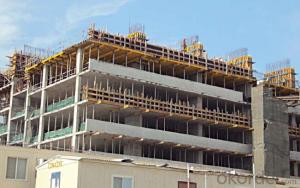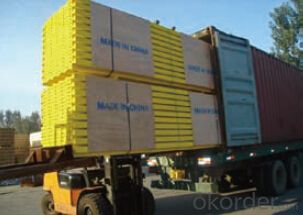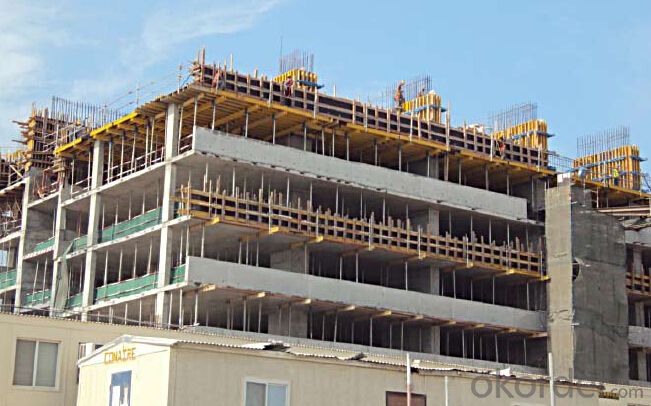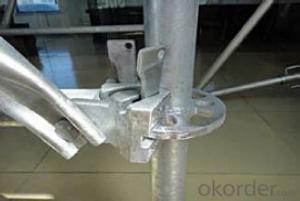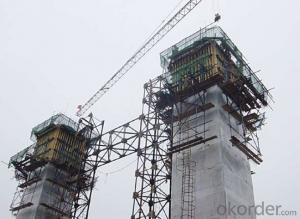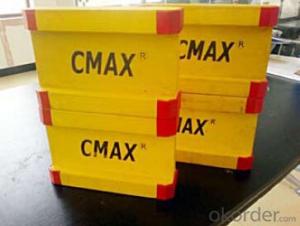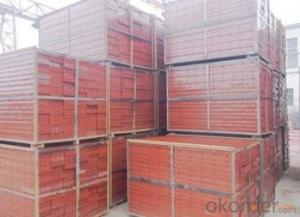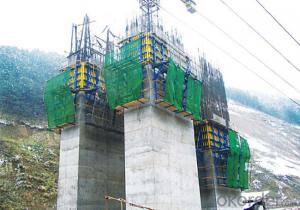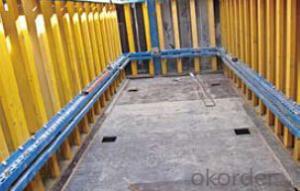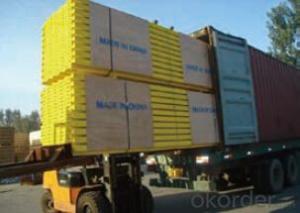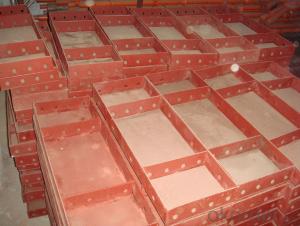Timber-Beam Formwork and H20 for formwork and scaffolding system
- Loading Port:
- Tianjin
- Payment Terms:
- TT OR LC
- Min Order Qty:
- 50 m²
- Supply Capability:
- 1000 m²/month
OKorder Service Pledge
OKorder Financial Service
You Might Also Like
Characteristics:
◆ Standardized production lines.
Supply capability: 3000m/day, Lmax = 6600mm.
◆ Finger jointing of the flange and web, the strength of timber beam is highly improved.
Max. shearing force failure load:40KN
◆ Well treated to prevent from water penetration or erosion, so the service life maximally
extended.
Normally, CNBM timber beam H20 can be used for 4 to 5 years, the exact using time would
depend on maintenance & storage.
◆ Robust caps at the end of the girders protect against damages.
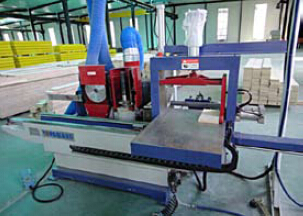
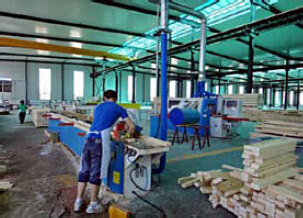
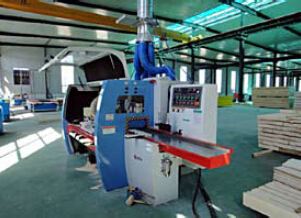
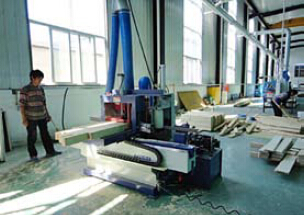
- Q: What are the standard sizes of steel formwork panels?
- The standard sizes of steel formwork panels can vary depending on the specific requirements of the construction project and the manufacturer. However, there are some commonly used standard sizes in the industry. Typically, steel formwork panels come in rectangular shapes with dimensions ranging from 1.2 meters to 2.4 meters in width and 1.8 meters to 3.6 meters in height. These standard sizes are designed to accommodate various construction needs and provide flexibility in forming structures such as walls, columns, slabs, and beams. The thickness of steel formwork panels can also vary, usually ranging from 12mm to 20mm. Thicker panels may be used for heavy-duty applications or to provide additional strength and durability to withstand the pressure exerted by concrete during pouring. It is worth noting that while these are common standard sizes, custom sizes can also be manufactured to meet specific project requirements. Additionally, some manufacturers may offer modular formwork systems that allow for easy assembly and disassembly by combining standard-sized panels in different configurations. Ultimately, the choice of steel formwork panel size depends on factors such as the size and complexity of the structure being formed, the load-bearing capacity required, and the ease of transportation and handling on the construction site.
- Q: Is steel formwork suitable for high-rise construction?
- Yes, steel formwork is suitable for high-rise construction. Steel formwork offers several advantages for high-rise construction projects. Firstly, steel formwork is strong and durable, capable of withstanding the high pressures and loads that are associated with constructing tall buildings. This ensures the safety and stability of the structure during the construction process. Secondly, steel formwork is highly versatile and can be easily customized to meet the specific requirements of high-rise construction. It can be designed and fabricated into various shapes and sizes, allowing for flexibility in creating different structural elements such as walls, columns, and slabs. This adaptability enables efficient construction and minimizes the need for extensive modifications or adjustments. Furthermore, steel formwork is reusable, which makes it cost-effective for high-rise construction projects. The ability to reuse steel formwork reduces the overall construction costs as it eliminates the need for constant purchase or fabrication of new formwork materials. This also contributes to a more sustainable construction practice by minimizing waste and promoting resource efficiency. Additionally, steel formwork provides a smooth and even surface finish, ensuring high-quality construction for high-rise buildings. The smooth finish reduces the need for extensive plastering or finishing works, saving time and resources during the construction process. In conclusion, steel formwork is indeed suitable for high-rise construction due to its strength, versatility, reusability, and ability to provide a smooth finish. These qualities make it an ideal choice for efficiently and effectively constructing tall buildings.
- Q: How does steel formwork prevent concrete mixture separation during pouring?
- Steel formwork is used in construction projects to provide a temporary structure that holds the concrete in place until it sets and hardens. One of the key benefits of using steel formwork is that it prevents the concrete mixture from separating during the pouring process. The steel formwork is carefully designed and constructed to create a tight enclosure for the concrete, ensuring that it remains in its desired shape and consistency. It is made up of steel panels and frames that are securely fastened together to create a rigid structure. When the concrete mixture is poured into the steel formwork, it is held in place by the walls of the formwork itself. The steel panels and frames provide a smooth and even surface for the concrete to be poured onto, preventing any separation or segregation of the mixture. Furthermore, the steel formwork is designed with properly aligned joints and connections, which further helps in preventing any leakage or seepage of the concrete mixture. This ensures that the concrete remains intact and does not separate into its constituent materials such as aggregates, cement, and water. Additionally, the steel formwork is capable of withstanding the pressure exerted by the weight of the concrete. This prevents any deformation or movement of the formwork during the pouring process, which could potentially cause the concrete to separate or shift. Overall, the use of steel formwork provides a strong and stable structure that prevents the concrete mixture from separating during pouring. It ensures that the concrete remains in its desired form and consistency, resulting in a high-quality and durable finished product.
- Q: Are there different sizes of steel formwork available?
- Indeed, a variety of sizes of steel formwork can be found. Steel formwork, a versatile construction material, sees extensive use in a multitude of building endeavors. Its inherent strength, durability, and stability render it well-suited for diverse applications. Customization of steel formwork to match specific project demands facilitates the creation of various shapes and structures, enabling flexibility. Moreover, the utilization of steel formwork facilitates efficient construction procedures, owing to its effortless assembly and disassembly, rendering it suitable for projects of all scales, be they small or large.
- Q: What are the common design considerations for steel formwork in heritage buildings?
- When it comes to the design of steel formwork in heritage buildings, there are various factors that must be taken into account. These considerations aim to maintain the historical and architectural significance of the building while ensuring efficient construction processes. Some of the main design considerations for steel formwork in heritage buildings include the following: 1. Preservation of Historical Value: The primary objective when designing steel formwork for heritage buildings is to preserve and protect the historical elements of the structure. The design must respect the building's original architectural features, materials, and construction methods, while also ensuring that the formwork adequately supports the weight of the concrete during the construction process. 2. Structural Stability: The steel formwork design should provide sufficient support and stability to the structure during the pouring and curing of the concrete. It is crucial to consider the load-bearing capacity of the formwork and ensure that it can withstand the weight of the concrete, reinforcing bars, and construction equipment without causing any damage to the heritage building. 3. Flexibility and Reusability: Since heritage buildings often require restoration or repairs over time, it is essential to design the steel formwork in a way that allows for easy disassembly and reuse. This consideration ensures that the formwork can be removed without causing any harm to the building and can be used again for future construction projects. 4. Aesthetic Considerations: In heritage buildings, maintaining the original architectural aesthetics is of utmost importance. The design of the steel formwork should take into account the visual impact it will have on the structure. This may involve incorporating decorative elements or finishes that match the existing architectural style or using formwork that can be concealed or removed once the concrete is set. 5. Accessibility and Safety: The design of the steel formwork should consider the safety requirements for both construction workers and the general public. It should ensure safe access to different areas of the building during construction and minimize any potential risks or hazards associated with formwork installation and removal. 6. Environmental Considerations: Sustainable design practices should be considered when designing steel formwork for heritage buildings. This may involve using recycled or low-impact materials, minimizing waste generation, and implementing energy-efficient construction techniques. In conclusion, the design considerations for steel formwork in heritage buildings revolve around the preservation of historical value, structural stability, flexibility, aesthetics, accessibility, safety, and environmental sustainability. By addressing these factors, architects and engineers can ensure that the construction process respects the heritage value of the building while meeting modern construction standards.
- Q: What are the different types of formwork anchors used in steel formwork?
- Steel formwork commonly uses various types of formwork anchors to secure the formwork to the structure and ensure construction process stability and safety. Examples of these formwork anchors include: 1. Wedge Anchor: This anchor has a threaded rod with a wedge-shaped end. By inserting it into a pre-drilled hole in the concrete structure and tightening a nut on the threaded end, a strong grip is formed. It is commonly used to secure formwork to concrete walls or slabs. 2. Screw Anchor: Also known as self-tapping anchors, these anchors are designed for use in softer materials like wood or light-gauge steel. They have a threaded body that can be screwed into the material, providing a secure connection for the formwork. Screw anchors are popular for temporary formwork applications due to their easy installation and removal. 3. Hook Anchor: This hook-shaped anchor is typically embedded into the concrete structure during the pouring process. The formwork is then attached to the hook using bolts or fasteners, creating a strong and reliable connection. Hook anchors are commonly used in applications with high loads or lateral forces. 4. Swift Lift Anchor: Specifically designed for lifting and handling precast concrete elements, including steel formwork, these anchors are embedded into the structure during pouring. They provide a safe and efficient method for lifting and positioning the formwork. 5. Plate Anchor: Plate anchors consist of a flat plate with holes for bolts or fasteners. They are versatile and commonly used in steel formwork systems to secure the formwork to the structure. Plate anchors can be easily adjusted or relocated as needed. 6. Chemical Anchor: Chemical anchors are used when a strong and permanent connection is required. They consist of a resin or adhesive injected into a pre-drilled hole in the concrete structure. The steel formwork is then attached to the chemical anchor, creating a secure bond. Each type of formwork anchor has unique advantages and is suitable for different applications. Factors such as the type of structure, load requirements, and duration of use should be considered when selecting the appropriate anchor and ensuring proper installation for the safety and stability of the formwork system.
- Q: How does steel formwork contribute to the overall constructability of complex structures?
- Steel formwork plays a crucial role in enhancing the overall constructability of complex structures in multiple ways. Firstly, steel formwork provides exceptional strength and durability, allowing it to withstand the heavy loads and pressures exerted during the construction process. This sturdiness ensures the stability and safety of the structure, reducing the risk of collapse or failure. Moreover, steel formwork offers immense flexibility and versatility in shaping various architectural elements, enabling the construction of intricate and complex designs. Its ability to be customized and adjusted easily allows for the creation of unique and aesthetically pleasing structures. Steel formwork also enhances construction efficiency by enabling faster assembly and disassembly compared to traditional formwork systems. The ease of installation and removal reduces construction time, leading to significant cost savings and increased productivity. Additionally, the reusable nature of steel formwork allows for multiple applications, making it a cost-effective choice in the long run. Furthermore, steel formwork is highly resistant to moisture, chemicals, and extreme weather conditions, ensuring its longevity and minimizing maintenance requirements. This durability makes it particularly suitable for complex structures, where long-term reliability is essential. Overall, steel formwork contributes to the overall constructability of complex structures by providing strength, flexibility, efficiency, and durability. Its ability to withstand heavy loads, create intricate designs, and speed up the construction process makes it an invaluable tool in the successful realization of complex architectural projects.
- Q: What are the considerations when designing steel formwork for underground structures?
- Several factors must be taken into account when designing steel formwork for underground structures. Firstly, the formwork must be able to withstand the pressure exerted by the surrounding soil. Underground structures face significant lateral and vertical loads, so the formwork must resist these forces without deforming or collapsing. Steel, with its high strength and rigidity, is an ideal material for this purpose. Secondly, the formwork should be designed for easy installation and removal. Underground construction presents challenges such as limited access and confined working spaces. Therefore, the formwork system should be modular and adjustable to fit different shapes and sizes of underground structures. This would allow for efficient construction and minimize the time and effort required for formwork installation and removal. Additionally, the formwork design should consider the ease of concrete pouring and curing. Proper placement of tie rods, formwork joints, and other structural elements is crucial to ensure smooth and even flow of concrete throughout the structure. The formwork system should also provide for ventilation and drainage to prevent water accumulation or air pockets that could compromise the structure's integrity. Moreover, safety is of utmost importance in designing steel formwork for underground structures. The formwork system should incorporate safety features like guardrails and access platforms to ensure a secure working environment for construction workers. The design should also minimize manual handling by utilizing lifting and handling equipment, reducing the risk of accidents or injuries during formwork installation and dismantling. Lastly, the formwork design should consider the project's budget and schedule constraints. While steel formwork may be more expensive than other types, cost-effective design solutions should be explored without compromising safety and performance. The formwork system should also be designed for reusability, allowing for multiple applications and reducing overall project costs. In conclusion, designing steel formwork for underground structures involves careful consideration of factors like strength, durability, ease of installation, concrete pouring, safety, and cost-effectiveness. By addressing these considerations, designers can ensure the successful construction of underground structures that meet project requirements and withstand the challenges of underground environments.
- Q: How does steel formwork handle different concrete surface gloss levels?
- Steel formwork is a versatile option that is capable of accommodating different concrete surface gloss levels effectively. It provides a smooth and even surface for concrete placement, allowing the desired finish to be achieved. Additionally, steel formwork is durable and can withstand the pressures and forces exerted by the concrete, ensuring that the surface gloss remains consistent throughout the curing process.
- Q: Can steel formwork be used for elevated water tanks?
- Yes, steel formwork can be used for elevated water tanks. Steel formwork is a versatile and durable construction material that can withstand the weight and pressure of water in elevated tanks. It provides a strong and stable structure for the tank, ensuring its integrity and longevity. Additionally, steel formwork allows for flexibility in design and can be easily assembled and disassembled, making it suitable for various tank sizes and configurations.
Send your message to us
Timber-Beam Formwork and H20 for formwork and scaffolding system
- Loading Port:
- Tianjin
- Payment Terms:
- TT OR LC
- Min Order Qty:
- 50 m²
- Supply Capability:
- 1000 m²/month
OKorder Service Pledge
OKorder Financial Service
Similar products
Hot products
Hot Searches
Related keywords

